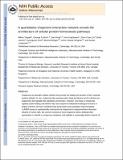| dc.contributor.author | Taipale, Mikko | |
| dc.contributor.author | Krykbaeva, Irina | |
| dc.contributor.author | Lin, Zhen-Yuan | |
| dc.contributor.author | Larsen, Brett | |
| dc.contributor.author | Choi, Hyungwon | |
| dc.contributor.author | Gingras, Anne-Claude | |
| dc.contributor.author | Tucker, George Jay | |
| dc.contributor.author | Peng, Jian | |
| dc.contributor.author | Berger, Bonnie A. | |
| dc.contributor.author | Lindquist, Susan | |
| dc.date.accessioned | 2016-12-05T20:51:04Z | |
| dc.date.available | 2016-12-05T20:51:04Z | |
| dc.date.issued | 2014-07 | |
| dc.date.submitted | 2014-03 | |
| dc.identifier.issn | 00928674 | |
| dc.identifier.issn | 1097-4172 | |
| dc.identifier.uri | http://hdl.handle.net/1721.1/105723 | |
| dc.description.abstract | Chaperones are abundant cellular proteins that promote the folding and function of their substrate proteins (clients). In vivo, chaperones also associate with a large and diverse set of cofactors (cochaperones) that regulate their specificity and function. However, how these cochaperones regulate protein folding and whether they have chaperone-independent biological functions is largely unknown. We combined mass spectrometry and quantitative high-throughput LUMIER assays to systematically characterize the chaperone-cochaperone-client interaction network in human cells. We uncover hundreds of chaperone clients, delineate their participation in specific cochaperone complexes, and establish a surprisingly distinct network of protein-protein interactions for cochaperones. As a salient example of the power of such analysis, we establish that NUDC family cochaperones specifically associate with structurally related but evolutionarily distinct β-propeller folds. We provide a framework for deciphering the proteostasis network and its regulation in development and disease and expand the use of chaperones as sensors for drug-target engagement. | en_US |
| dc.description.sponsorship | National Institutes of Health (U.S.) (Grant GM081871) | en_US |
| dc.language.iso | en_US | |
| dc.publisher | Elsevier | en_US |
| dc.relation.isversionof | http://dx.doi.org/10.1016/j.cell.2014.05.039 | en_US |
| dc.rights | Creative Commons Attribution-NonCommercial-NoDerivs License | en_US |
| dc.rights.uri | http://creativecommons.org/licenses/by-nc-nd/4.0/ | en_US |
| dc.source | PMC | en_US |
| dc.title | A Quantitative Chaperone Interaction Network Reveals the Architecture of Cellular Protein Homeostasis Pathways | en_US |
| dc.type | Article | en_US |
| dc.identifier.citation | Taipale, Mikko et al. “A Quantitative Chaperone Interaction Network Reveals the Architecture of Cellular Protein Homeostasis Pathways.” Cell 158.2 (2014): 434–448. | en_US |
| dc.contributor.department | Massachusetts Institute of Technology. Computer Science and Artificial Intelligence Laboratory | en_US |
| dc.contributor.department | Massachusetts Institute of Technology. Department of Biology | en_US |
| dc.contributor.department | Massachusetts Institute of Technology. Department of Mathematics | en_US |
| dc.contributor.department | Whitehead Institute for Biomedical Research | en_US |
| dc.contributor.mitauthor | Tucker, George Jay | |
| dc.contributor.mitauthor | Peng, Jian | |
| dc.contributor.mitauthor | Berger, Bonnie A. | |
| dc.contributor.mitauthor | Lindquist, Susan | |
| dc.relation.journal | Cell | en_US |
| dc.eprint.version | Author's final manuscript | en_US |
| dc.type.uri | http://purl.org/eprint/type/JournalArticle | en_US |
| eprint.status | http://purl.org/eprint/status/PeerReviewed | en_US |
| dspace.orderedauthors | Taipale, Mikko; Tucker, George; Peng, Jian; Krykbaeva, Irina; Lin, Zhen-Yuan; Larsen, Brett; Choi, Hyungwon; Berger, Bonnie; Gingras, Anne-Claude; Lindquist, Susan | en_US |
| dspace.embargo.terms | N | en_US |
| dc.identifier.orcid | https://orcid.org/0000-0003-1307-882X | |
| mit.license | PUBLISHER_CC | en_US |
